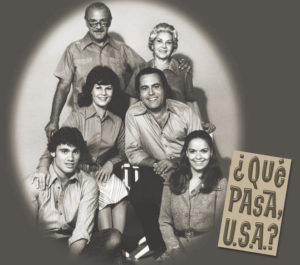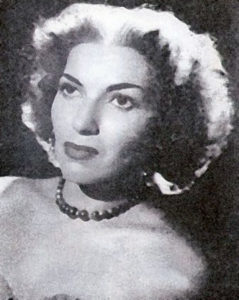VELIA MARTÍNEZ, DISTINGUIDA ACTRIZ, CANTANTE Y BAILARINA CUBANA. QUE PASA U.S.A. VÍDEOS
Velia Martínez Febles fue una reconocida actriz, cantante y ex bailarina.
Nacida el 14 de junio de 1920 en Tampa, Florida, de padre cubano Cristóbal Martínez y madre nativa de Florida, Amparo Febles (cuyos padres eran cubanos).
En 1941 se radicó en La Habana, donde se convirtió en una reconocida personalidad del mundo del espectáculo.
Fue una consumada bailarina y estrella de cabaret, actuó en los teatros más prestigiosos de Cuba, incluido el Cabaret Montmartre.
En 1945, estando en México, se casó con el actor, productor y escritor cubano Ramiro Gómez Kemp (1914-1981). Tuvieron dos hijas Georgina y Mayra Cristina.
En 1945 interpretó el papel principal en la obra Filomena Marturano en el Teatro Thalia de La Habana, considerado el papel fundamental de su carrera. En 1958 actuó junto a Errol Flynn en la película The Big Boodle.
VIDEOS- VELIA MARTINEZ EN QUE PASA U.S.A..
Salió de Cuba en 1960 con su familia y vivió dos años en Puerto Rico, donde apareció en la telenovela Yo Compro Esa Mujer. En 1962 llegó a Miami y continuó actuando en los escenarios.
En 1965 actuó en Mi hijo no es lo que las costuras, en el Teatro Martí. En 1966 apareció en la película La hermana del diablo como Carmen Alvarado.
En 1965 actuó en Mi Hijo No Es Lo Que Parece, en el Teatro Martí. En 1966, apareció en la película La hermana del diablo como Carmen Alvarado.
En 1977, alcanzó la cima de la popularidad como la abuela Adela en la serie de PBS ¿Qué Pasa, USA?.
QUE PASA EE.UU.?
¿Qué pasa, EE.UU.? fue la primera comedia de situación bilingüe de Estados Unidos y la primera comedia de situación producida para PBS. Fue producido y grabado frente a una audiencia de estudio en vivo en la estación miembro de PBS WPBT en Miami, Florida y transmitido en estaciones miembros de PBS en todo el país. La serie inicialmente duró cuatro temporadas entre 1977 y 1980 (se produjeron 39 episodios) y continúa transmitiéndose.
El programa exploró las pruebas y tribulaciones que enfrentaron los Peña, una familia cubanoamericana que vive en el barrio de La Pequeña Habana de Miami, mientras luchaban por hacer frente a un nuevo país y un nuevo idioma. La serie fue elogiada por ser muy realista y retratar con precisión, aunque con humor, la vida y la cultura de la población cubanoamericana de Miami.
La serie se centró en la crisis de identidad de los miembros de la familia, ya que fueron empujados en una dirección por sus mayores, que querían mantener los valores y tradiciones cubanos, y en otras direcciones por las presiones de vivir en una sociedad predominantemente angloamericana. . Esto provocó muchas desventuras para toda la familia Peña, ya que se vieron arrastrados en todas direcciones en su intento por preservar su patrimonio.
La serie era bilingüe, lo que reflejaba la mezcla de idiomas que se escucha a menudo en los barrios cubanoamericanos: desde el español en casa y el inglés en el supermercado hasta la inevitable combinación de ambos en el “spanglish”. El uso del lenguaje en el programa también fue paralelo a las diferencias generacionales de la vida real en muchas familias cubanoamericanas de la época.
Su última gran actuación en el escenario fue en 1989 en la obra de Luis Santeiro, Bendiciones Mixtas en el Coconut Grove Playhouse y su último papel televisivo fue el de Elena, dueña de una peluquería en la serie Corte Tropical de Univisión en 1992.
Murió el 22 de mayo de 1993 en Miami, Florida.
FILMOGRAFÍA
Loco y vagabundo (1946)
En 1958 protagonizó junto a Errol Flynn la película The Big Boodle.
La Hermana del Diablo(1966)
VELIA MARTINEZ, DISTINGUISHED CUBAN ACTRESS, SINGER AND DANCER. QUE PASA U.S.A.? VIDEOS
Velia Martínez Febles was a well-known actress, singer and former nightclub dancer.
Born June 14, 1920 in Tampa, Florida to Cuban father Cristobal Martinez and Florida native mother Amparo Febles (whose parents were Cuban).
In 1941, she settled in Havana, where she became a well-known show business personality.
She was an accomplished dancer and cabaret star, she performed in Cuba’s most prestigious theaters including the Cabaret Montmartre.
In 1945, while in Mexico, she married the Cuban actor, producer and writer, Ramiro Gómez Kemp (1914-1981). They had two daughters Georgina and Mayra Cristina.
In 1945, she played the title role in the play Filomena Marturano in Havana’s Thalia Theater, which is considered her pivotal role in her career. In 1958 she acted opposite Errol Flynn in the movie The Big Boodle.
She left Cuba in 1960 with her family and lived two years in Puerto Rico where she appeared in a TV soap opera Yo Compro Esa Mujer (I’ll Buy That Woman). In 1962, she came to Miami and continued performing on stage.
In 1962, he arrived in Miami and continues to perform on stage. In 1965, she appeared in My Son is Not What the Seams, at the Teatro Martí. In 1966, she appeared in the film The Devil’s Sister as Carmen Alvarado.
In 1965 she appeared in My Son Is Not What He Appears (Mi Hijo No Es Lo Que Parece), at the Martí Theater. In 1966, she appeared in the movie, The Devil’s Sister as Carmen Alvarado.
In 1977, she reached the pinnacle of popularity as the grandmother Adela in the PBS series ¿Qué Pasa, USA?. Her last great performance on stage was in 1989 in Luis Santiero’s play, Mixed Blessings at the Coconut Grove Playhouse and her last television role was of Elena, a hair salon owner in the Univision series Corte Tropical in 1992.
QUE PASA U.S.A.
¿Qué Pasa, U.S.A.? was America’s first bilingual situation comedy, and the first sitcom to be produced for PBS. It was produced and taped in front of a live studio audience at PBS member station WPBT in Miami, Florida and aired on PBS member stations nationwide. The series initially ran for four seasons from 1977-1980 (39 episodes were produced) and continues to run in syndication.
The program explored the trials and tribulations faced by the Peñas, a Cuban-American family living in Miami’s Little Havana neighborhood, as they struggled to cope with a new country and a new language. The series was praised as being very true-to-life and accurately, if humorously, portraying the life and culture of Miami’s Cuban-American population.
The series focused on the identity crisis of the members of the family as they were pulled in one direction by their elders – who wanted to maintain Cuban values and traditions – and pulled in other directions by the pressures of living in a predominantly Anglo-American society. This caused many misadventures for the entire Peña family as they get pulled in all directions in their attempt to preserve their heritage.
The series was bilingual, reflecting the mix of language often heard in Cuban-American neighborhoods – from Spanish in the home and English at the supermarket to the inevitable combining of both into “Spanglish”. The use of language in the show also paralleled the real-life generational differences in many Cuban-American families of the era.
Her last great performance on stage was in 1989 in Luis Santeiro’s play, Mixed Blessings at the Coconut Grove Playhouse and her last television role was of Elena, a hair salon owner in the Univision series Corte Tropical in 1992.
She died May 22, 1993 in Miami, Florida
FILMOGRAPHY
Madman and Vagabond (1946)
In 1958 he starred alongside Errol Flynn in the film The Big Boodle.
Agencies/ Wiki/ VeliaMartinezBio./ Extractos/ Excerpts/ Internet Photos/ YouTube/ Arnoldo Varona/ www.TheCubanHistory.com
THE CUBAN HISTORY/ HOLLYWOOD.



 VELIA MARTÍNEZ, distinguida Actriz, cantante y Bailarina Cubana. Que Pasa U.S.A.?. * VELIA MARTÍNEZ, distinguished Cuban actress, singer and dancer. Que Pasa U.S.A.? . PHOTOS. VIDEOS.
VELIA MARTÍNEZ, distinguida Actriz, cantante y Bailarina Cubana. Que Pasa U.S.A.?. * VELIA MARTÍNEZ, distinguished Cuban actress, singer and dancer. Que Pasa U.S.A.? . PHOTOS. VIDEOS.




